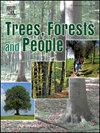The community perception of mistletoe management for Vachellia woodlands conservation:A case study in AlUla county, Saudi Arabia
IF 2.7
Q1 FORESTRY
引用次数: 0
Abstract
The woodlands in arid regions are considered very important ecosystems that provide various ecological and economic services. The sustainable management programs for this ecosystem, such as mistletoe interventions relies on integrating socio-cultural valuations of ecosystem services with ecological assessments. However, limited research has been conducted on community perceptions of mistletoe management. This study aims to determine the perceptions of the community in the AlUla county, Saudi Arabia, regarding the effect of mistletoe (Plicosepalus acaciae) on Vachellia woodlands and the current status of management practices, implemented and suggested for co-management with relevant authorities. An analytical framework was designed to analyze community-based management across three main areas: perception of mistletoe, the extent of its spread, and approaches to its management. Through a combination of field observations, tree surveys, interviews, and focus group discussions, the study offers valuable insights into the effects of mistletoe and management strategies. The empirical findings reveal that the local community has a stronger perception of mistletoe's adverse effects on trees, infection levels in wadis (valleys), and its transmission between trees compared to pastoralists. Most of the local community has observed mistletoe for 15–20 years, confirming the infection's progression over time. The study findings also revealed that, historically, the community has managed mistletoe in different ways, including feeding it to camels, using it in traditional medicine, and harvesting it for therapeutic purposes. The community has offered promising suggestions to enhance mistletoe control efforts, such as collaborating with pharmaceutical companies to develop business plans for mistletoe collection, conducting experiments to evaluate its potential as animal feed, and providing incentives to encourage mechanical control methods. A deeper understanding of community perceptions offers valuable insights for policymakers in decision-making and the design of collaborative mistletoe management plans.
社区对槲寄生管理对桦树林地保护的认知:以沙特阿拉伯AlUla县为例
干旱地区的林地被认为是非常重要的生态系统,提供各种生态和经济服务。该生态系统的可持续管理计划,如槲寄生干预,依赖于将生态系统服务的社会文化价值与生态评估相结合。然而,对社区对槲寄生管理的看法进行了有限的研究。本研究旨在确定沙特阿拉伯AlUla县社区对槲寄生(Plicosepalus acaciae)对Vachellia林地的影响的看法,以及与有关当局实施和建议共同管理的管理做法的现状。设计了一个分析框架来分析三个主要领域的社区管理:对槲寄生的认识、其传播程度和管理方法。通过实地观察、树木调查、访谈和焦点小组讨论的结合,该研究为槲寄生的影响和管理策略提供了有价值的见解。实证研究结果表明,与牧民相比,当地社区对槲寄生对树木的不利影响、山谷中的感染水平以及树木之间的传播有更强的认识。大多数当地社区已观察槲寄生15-20年,证实了感染随时间的进展。研究结果还表明,从历史上看,该社区以不同的方式管理槲寄生,包括喂骆驼,将其用于传统医学,以及将其收获用于治疗目的。社区为加强槲寄生控制工作提出了有希望的建议,例如与制药公司合作制定槲寄生收集的商业计划,进行实验以评估其作为动物饲料的潜力,以及提供奖励以鼓励机械控制方法。对社区观念的更深入理解为决策者在决策和设计协作槲寄生管理计划时提供了有价值的见解。
本文章由计算机程序翻译,如有差异,请以英文原文为准。
求助全文
约1分钟内获得全文
求助全文
来源期刊

Trees, Forests and People
Economics, Econometrics and Finance-Economics, Econometrics and Finance (miscellaneous)
CiteScore
4.30
自引率
7.40%
发文量
172
审稿时长
56 days
 求助内容:
求助内容: 应助结果提醒方式:
应助结果提醒方式:


